The Effects of Infilled Walls on Seismic Performance of RC Frame Structures with Eccentrically Placed Open Corridor
Abstract
1. Introduction
2. Information of the Model
2.1. Design of the Model
2.2. The Similarity Ratio
2.3. Properties of Materials
2.4. Test System
3. Results and Discussion
3.1. Modal Tests
3.1.1. Natural Frequency
3.1.2. Damping Ratio
3.2. Structural Response in Percussion Test
3.2.1. Reliability of Strain
3.2.2. Internal Force Distribution of Columns
3.3. Structural Seismic Test
3.3.1. Seismic Input
3.3.2. Displacement of Bottom Floor
3.3.3. Strain of the Bottom Column
3.3.4. Structural Damage and Collapse
4. Conclusions
- (1)
- After the infilled wall is installed in the frame, its natural frequency and damping ratio increase significantly.
- (2)
- The form of the infilled wall has a great influence on the lateral stiffness of the structure. The transverse walls in the teaching buildings generally do not have openings, while the longitudinal walls are often provided with doors and windows. Such kinds of spatial arrangements lead to a much greater lateral stiffness in the transverse direction than in the longitudinal direction of this type of structure. Specifically, the transverse fundamental frequency of the frame structure with the infilled wall is about twice that of the vertical one.
- (3)
- When analysing the force and deformation of the frame, its effect of the space with longitudinal and transverse infilled walls should be considered. In general, the stiffness of the transverse infilled wall is very large, which will restrain the transverse deformation of the structure to a certain extent and finally present a deformation translating longitudinally during an earthquake.
- (4)
- At present, the frame with eccentrically placed open corridors, which has “inherent” seismic defects, is mostly adopted in school teaching buildings. The columns with lateral stiffness of a big difference along the longitudinal axis of the structure, especially those constrained by the longitudinal half-height continuous infilled wall, firstly form plastic hinges and lose load-bearing capacity, further resulting in the collapse of the structure.
Author Contributions
Funding
Institutional Review Board Statement
Informed Consent Statement
Data Availability Statement
Conflicts of Interest
References
- Li, H.-N.; Xiao, S.-Y.; Huo, L.-S. Damage investigation and analysis of engineering structures in the Wenchuan earthquake. J. Build. Struct. 2008, 29, 10–19. [Google Scholar]
- Guo, X. Characteristics and mechanism analysis of the great Wenchuan earthquake. Earthq. Eng. Eng. Dyn. 2009, 29, 74–87. [Google Scholar]
- Yang, W.-S.; Guo, X.; Xu, W.-X.; Yuan, X. Seismic behaviours of RC frames retrofitted with wing walls. J. Vib. Shock 2015, 34, 144–152. [Google Scholar]
- Tan, H.; Li, J.; Zhang, D.-J.; Zhang, Z.-Q. Earthquake damage investigation on red flag primary school buildings in yushu autonomous prefecture. World Earthq. Eng. 2011, 27, 96–101. [Google Scholar]
- Kishiki, S.; Yamada, S.; Matsumoto, Y.; Asada, H.; Koyama, T.; Shimada, Y. Damage to column bases and roof joints in steel school buildings due to the 2011 Tohoku earthquake. AIJ J. Technol. Des. 2013, 19, 585–590. [Google Scholar] [CrossRef][Green Version]
- Li, J.-W.; Bo, J.-S.; Lu, T.; Cai, X.-G.; Zhang, J.-Y. Seismic damage analysis of school buildings in Yushu Ms 7.1 earthquake. J. Nat. Disasters 2013, 22, 123–129. [Google Scholar]
- Sun, B.-T.; Zhou, Q.; Yang, Y.-C. Seismic fortification objects of rural primary and middle schools: The damage cause study for primary and middle school buildings of Leigu town, Beichuan county in Wenchuan earthquake. J. Earthq. Eng. Eng. Vib. 2011, 31, 1–10. [Google Scholar]
- Bal, İ.-E.; Smyrou, E. Simulation of the earthquake-induced collapse of a school building in Turkey in 2011 Van Earthquake. Bull. Earthq. Eng. 2016, 14, 3509–3528. [Google Scholar] [CrossRef]
- Bo, J.-S.; Li, X.-B.; Duan, Y.-S.; Su, Z.-D. Investigation and analysis of seismic damage to school buildings in m_s7.0 Jiuzhaigou earthquake. Earthq. Eng. Eng. Dyn. 2018, 38, 120–128. [Google Scholar]
- Giordano, N.; Luca, F.-D.; Sextos, A. Analytical fragility curves for masonry school building portfolios in Nepal. Bull. Earthq. Eng. 2021, 19, 1121–1150. [Google Scholar]
- Ruggieri, S.; Porco, F.; Uva, G.; Vamvatsikos, D. Two frugal options to assess class fragility and seismic safety for low-rise reinforced concrete school buildings in southern Italy. Bull. Earthq. Eng. 2021, 19, 1415–1439. [Google Scholar] [CrossRef]
- Zhai, C.-H.; Wang, X.-M.; Kong, J.-C.; Wei, Y.-L.; Jin, W.; Zhao, Y. Progress and prospect of seismic performance of masonry-infilled RC frames. J. Harbin Inst. Technol. 2018, 50, 1–13. [Google Scholar]
- Zhang, W.-X.; Pang, B.; Xu, S. Research on bottom column end moment amplification factor of RC frame based on incremental dynamic analysis and fragility analysis. J. Chongqing Univ. 2019, 42, 37–45. [Google Scholar]
- Noh, N.M.; Liberatore, L.; Mollaioli, F.; Tesfamariam, S. Modelling of masonry infilled RC frames subjected to cyclic loads: State of the art review and modelling with Open Sees. Eng. Struct. 2017, 150, 599–621. [Google Scholar]
- Jin, H.-G.; Li, H.-J.; Sun, G.-J. Analysis of interaction between reinforced concrete frame and infilled wall subject to earthquake-induced ground motion. Earthq. Eng. Eng. Dyn. 2017, 37, 31–41. [Google Scholar]
- Ruggieri, S.; Fiore, A.; Uva, G. A new approach to predict the fundamental period of vibration for newly-designed reinforced concrete buildings. J. Earthq. Eng. 2021, 1–26. [Google Scholar] [CrossRef]
- Chakra-Varthy, P.; Basu, D. Natural period and vertical distribution of base shear in confined masonry buildings using ambient vibration test. Bull. Earthq. Eng. 2021, 19, 1851–1899. [Google Scholar] [CrossRef]
- Yousefianmoghadam, S.; Behmanesh, I.; Stavridis, A.; Moaveni, B.; Nozari, A.; Sacco, A. System identification and modelling of a dynamically tested and gradually damaged 10-story reinforced concrete building. Earthq. Eng. Struct. Dyn. 2018, 47, 25–47. [Google Scholar] [CrossRef]
- Furtado, A.; De Risi, M.T. Recent findings and open Issues concerning the seismic behaviour of masonry infill walls in RC buildings. Adv. Civ. Eng. 2020, 2020, 9261716. [Google Scholar] [CrossRef]
- Shan, S.; Li, S. Progressive collapse mechanisms of post-tensioned reinforced concrete frames considering effect of infill walls. Eng. Struct. 2022, 250, 1–16. [Google Scholar] [CrossRef]
- Singh, B.; Ramesh, K.-V.; Sudheer, G.; Ramesh, C.-R. Comparison of reinforced concrete frames modelled with and without infill walls. Int. J. Civ. Eng. Technol. 2017, 8, 1636–1644. [Google Scholar]
- Işık, E.; Aydın, M.-C.; Ulu, A.-E. Comparison of infill wall effects in reinforced-concrete frames over different parameters. Adv. Eng. Sci. 2022, 2, 80–86. [Google Scholar]
- Jahangir, H.; Esfahani, M.-R. Bond behaviour investigation between steel reinforced grout composites and masonry substrate. Iran. J. Sci. Technol. 2022, 1–17. [Google Scholar] [CrossRef]
- Benavent-Climent, A.; Ramírez-Márquez, A.; Pujol, S. Seismic strengthening of low-rise reinforced concrete frame structures with masonry infill walls: Shaking-table test. Eng. Struct. 2018, 165, 142–151. [Google Scholar] [CrossRef]
- Guljaš, I.; Penava, D.; Laughery, L.; Pujol, S. Dynamic tests of a large-scale three-story RC structure with masonry infill walls. J. Earthq. Eng. 2018, 24, 1675–1703. [Google Scholar] [CrossRef]
- Lourenço, P.-B.; Leite, J.-M.; Paulo-Pereira, M.-F.; Campos-Costa, A.; Candeias, P.-X.; Mendes, N. Shaking table testing for masonry infill walls: Unreinforced versus reinforced solutions. Earthq. Eng. Struct. Dyn. 2016, 45, 2241–2260. [Google Scholar] [CrossRef]
- Hashemi, A.; Mosalam, K.-M. Shake-table experiment on reinforced concrete structure containing masonry infill wall. Earthq. Eng. Struct. Dyn. 2006, 35, 1827–1852. [Google Scholar] [CrossRef]
- Binici, B.; Canbay, E.; Aldemir, A.; Demirel, I.-O.; Uzgan, U.; Eryurtlu, Z.; Bulbul, K.; Yakut, A. Seismic behaviour and improvement of autoclaved aerated concrete infill walls. Eng. Struct. 2019, 193, 68–81. [Google Scholar] [CrossRef]
- Papatheocharis, T.; Perdikaris, P.-C.; Moretti, M.-L. Response of RC frames strengthened by RC infill walls: Experimental study. J. Struct. Eng. 2019, 11, 04019129. [Google Scholar] [CrossRef]
- Sanada, Y.; Maidiawati. Modelling of interactions between RC columns and masonry infill in buildings with a column-sway mechanism. Jpn. Archit. Rev. 2018, 1, 109–117. [Google Scholar] [CrossRef]
- Onat, O.; Correia, A.-A.; Lourenço, P.-B.; Koçak, A. Assessment of the combined in-plane and out-of-plane behaviour of brick infill walls within reinforced concrete frames under seismic loading. Earthq. Eng. Struct. Dyn. 2018, 47, 2821–2839. [Google Scholar] [CrossRef]
- Dautaj, A.-D.; Kadiri, Q.; Kabashi, N. Experimental study on the contribution of masonry infill in the behaviour of RC frame under seismic loading. Eng. Struct. 2018, 165, 27–37. [Google Scholar] [CrossRef]
- Basha, S.-H.; Kaushik, H.-B. Behavior and failure mechanisms of masonry-infilled RC frames (in low-rise buildings) subject to lateral loading. Eng. Struct. 2016, 111, 233–245. [Google Scholar] [CrossRef]
- Brodsky, A.; Rabinovitch, O.; Yankelevsky, D.Z. Determination of the interaction between a masonry wall and a confining frame. Eng. Struct. 2018, 167, 214–226. [Google Scholar] [CrossRef]
- Penava, D.; Sarhosis, V.; Kožar, I.; Guljaš, I. Contribution of RC columns and masonry wall to the shear resistance of masonry infilled RC frames containing different in size window and door openings. Eng. Struct. 2018, 172, 105–130. [Google Scholar] [CrossRef]
- Guo, Z.-X.; Huang, Q.-X.; Wei, R.-F.; Liu, Y. Experimental study of the seismic behaviour of irregularly brick infilled RC frames. China Civ. Eng. J. 2010, 43, 46–54. [Google Scholar]
- Peng, Q.-M.; Zhou, X.-J.; Yang, C.-H. Influence of connection and constructional details on masonry-infilled RC frames under cyclic loading. Soil Dyn. Earthq. Eng. 2018, 108, 96–110. [Google Scholar] [CrossRef]
- Baghi, H.; Oliveira, A.; Valença, J.; Cavaco, E.; Neves, L.; Júlio, E. Behaviour of reinforced concrete frame with masonry infill wall subjected to vertical load. Eng. Struct. 2018, 171, 476–487. [Google Scholar] [CrossRef]
- Razzaghi, M.S.; Javidnia, M. Evaluation of the effect of infill walls on seismic performance of RC dual frames. Int. J. Adv. Struct. Eng. 2015, 7, 49–54. [Google Scholar] [CrossRef]
- Ricci, P.; Domenico, M.-D.; Verderame, G.-M. Experimental assessment of the in-plane/out-of-plane interaction in unreinforced masonry infill walls. Eng. Struct. 2018, 173, 960–978. [Google Scholar] [CrossRef]
- Pantò, B.; Silva, L.; Vasconcelos, G.; Lourenço, P.-B. Macro-modelling approach for assessment of out-of-plane behaviour of brick masonry infill walls. Eng. Struct. 2019, 181, 529–549. [Google Scholar] [CrossRef]
- Al Hanoun, M.-H.; Abrahamczyk, L.; Schwarz, J. Macromodeling of in- and out-of-plane behaviour of unreinforced masonry infill walls. Bull. Earthq. Eng. 2019, 17, 519–535. [Google Scholar] [CrossRef]
- Zhang, M.-Z. Concept and Application of Earthquake Engineering; Seismological Press: Beijing, China, 2015; pp. 177–184. [Google Scholar]
- Guo, X. Collapse Mechanism of RC Frame Structures Suffered from Strong Earthquake; Architecture & Building Press: Beijing, China, 2018; pp. 20–21. [Google Scholar]
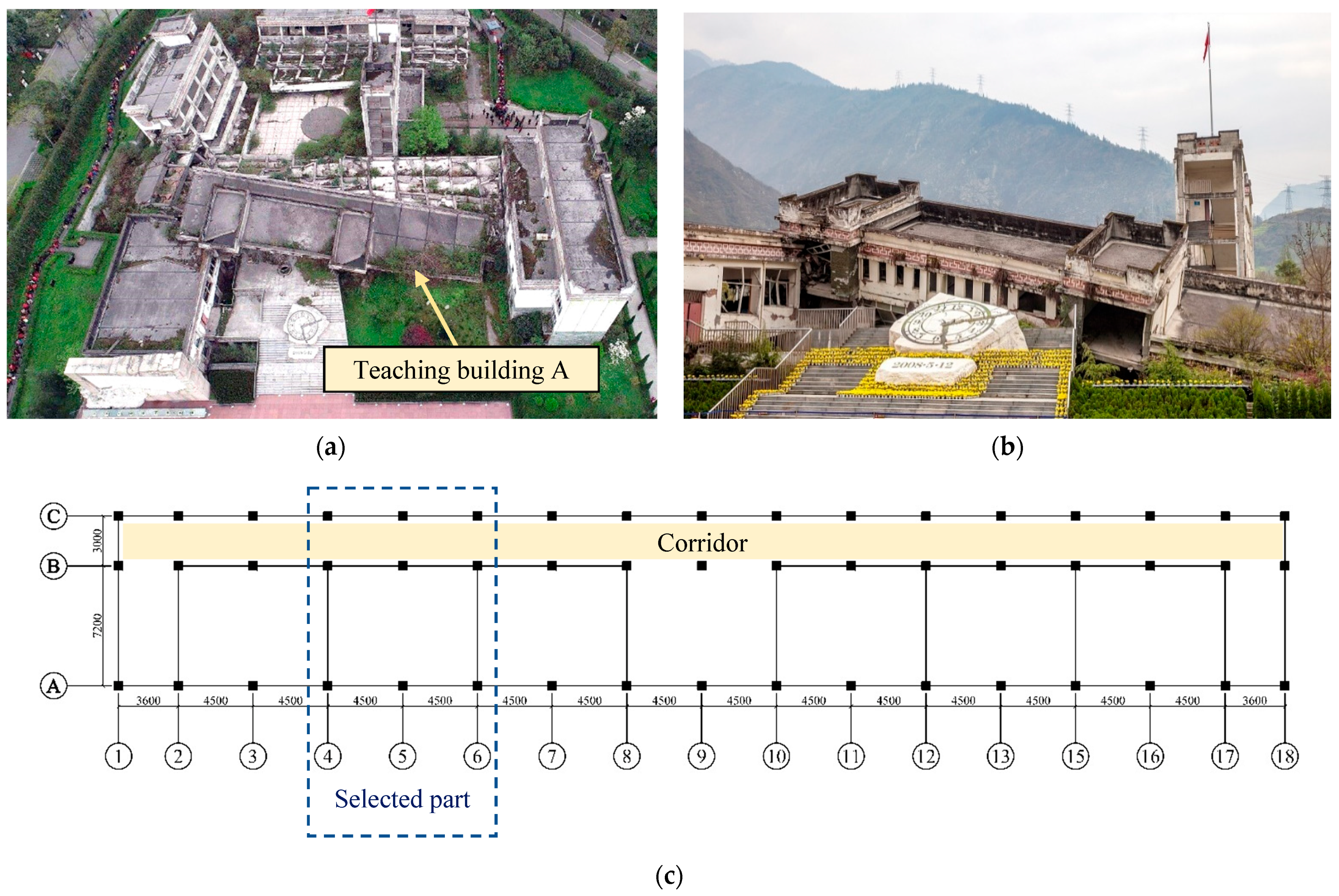
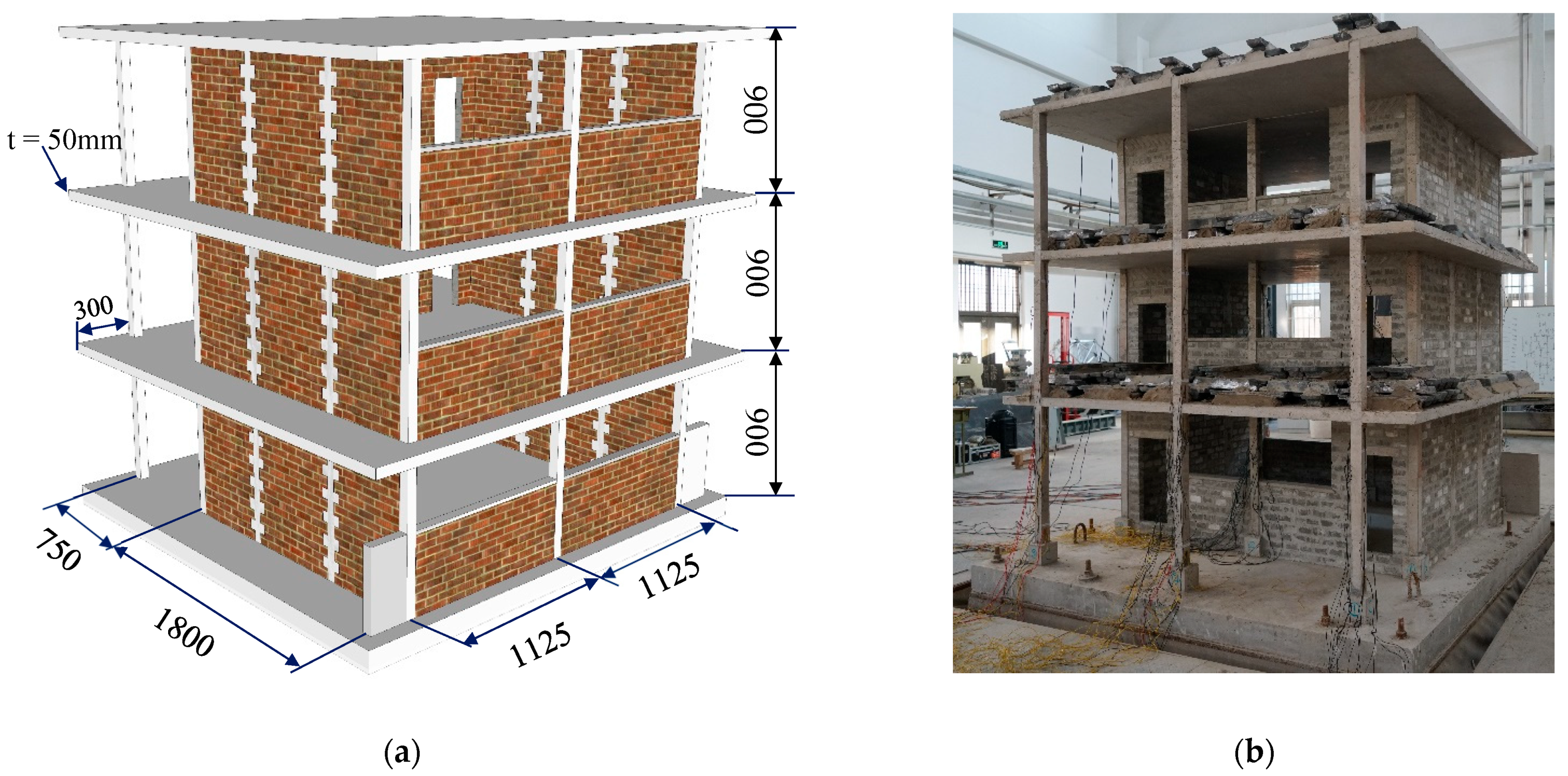
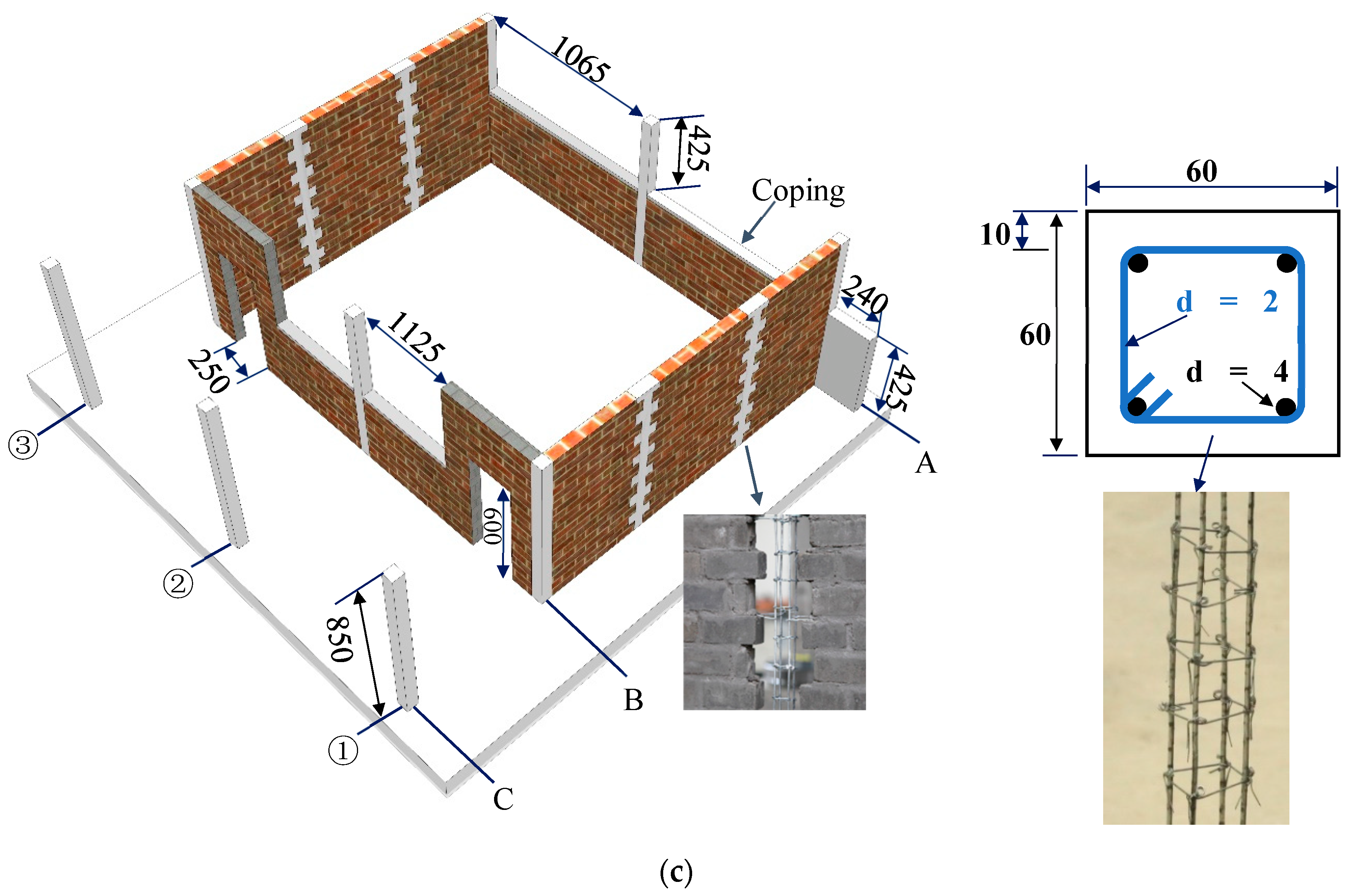
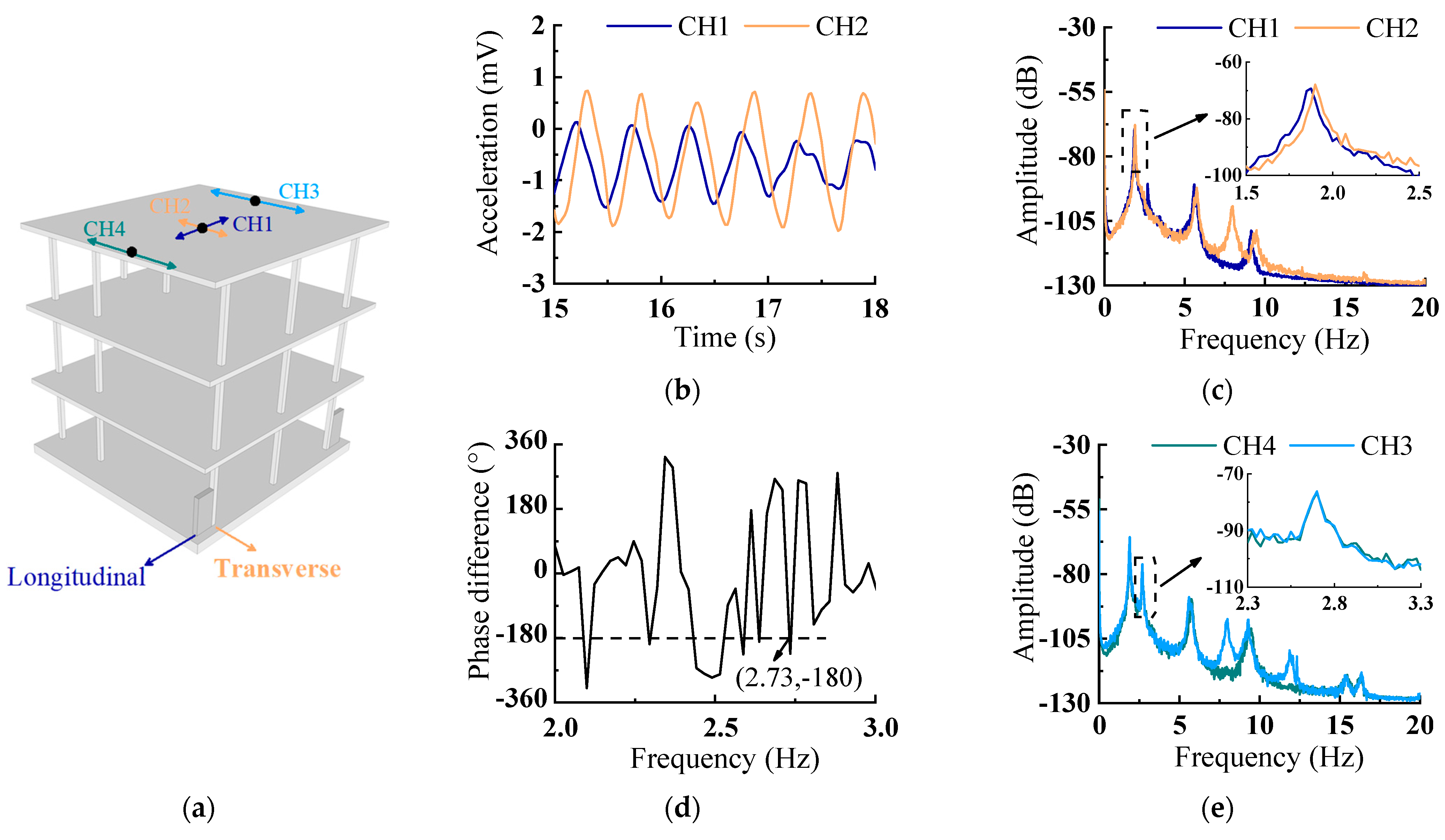
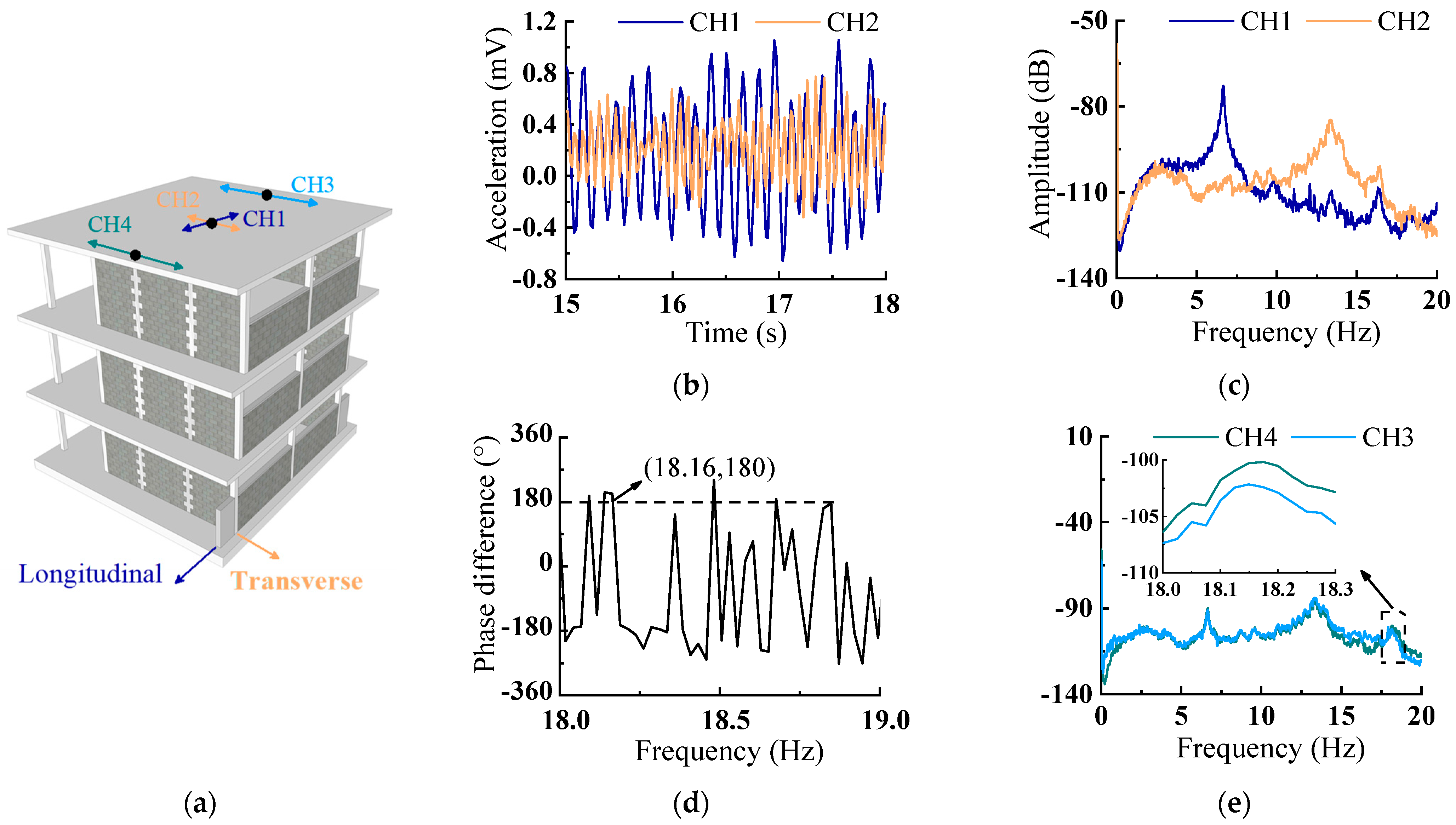
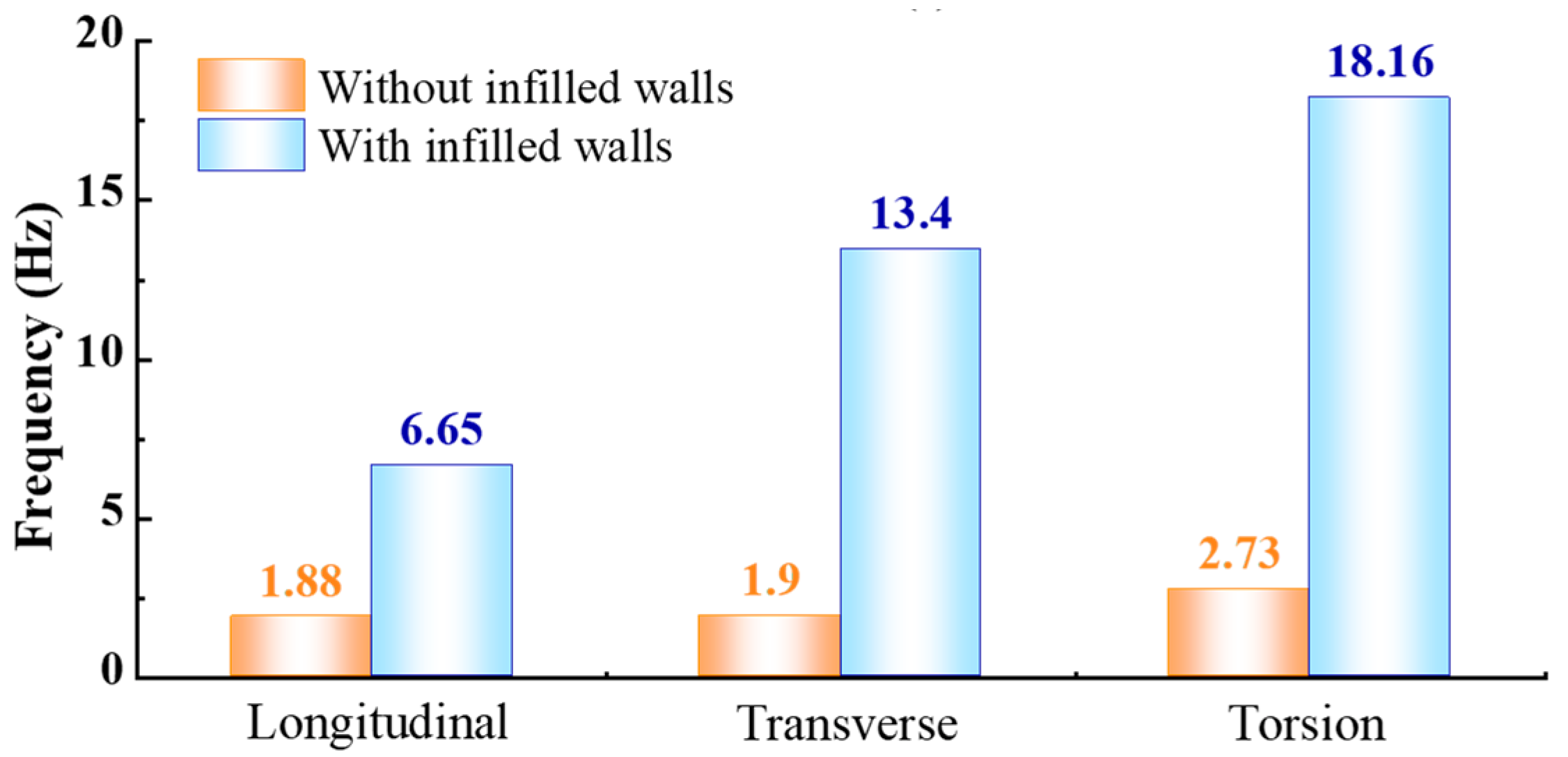
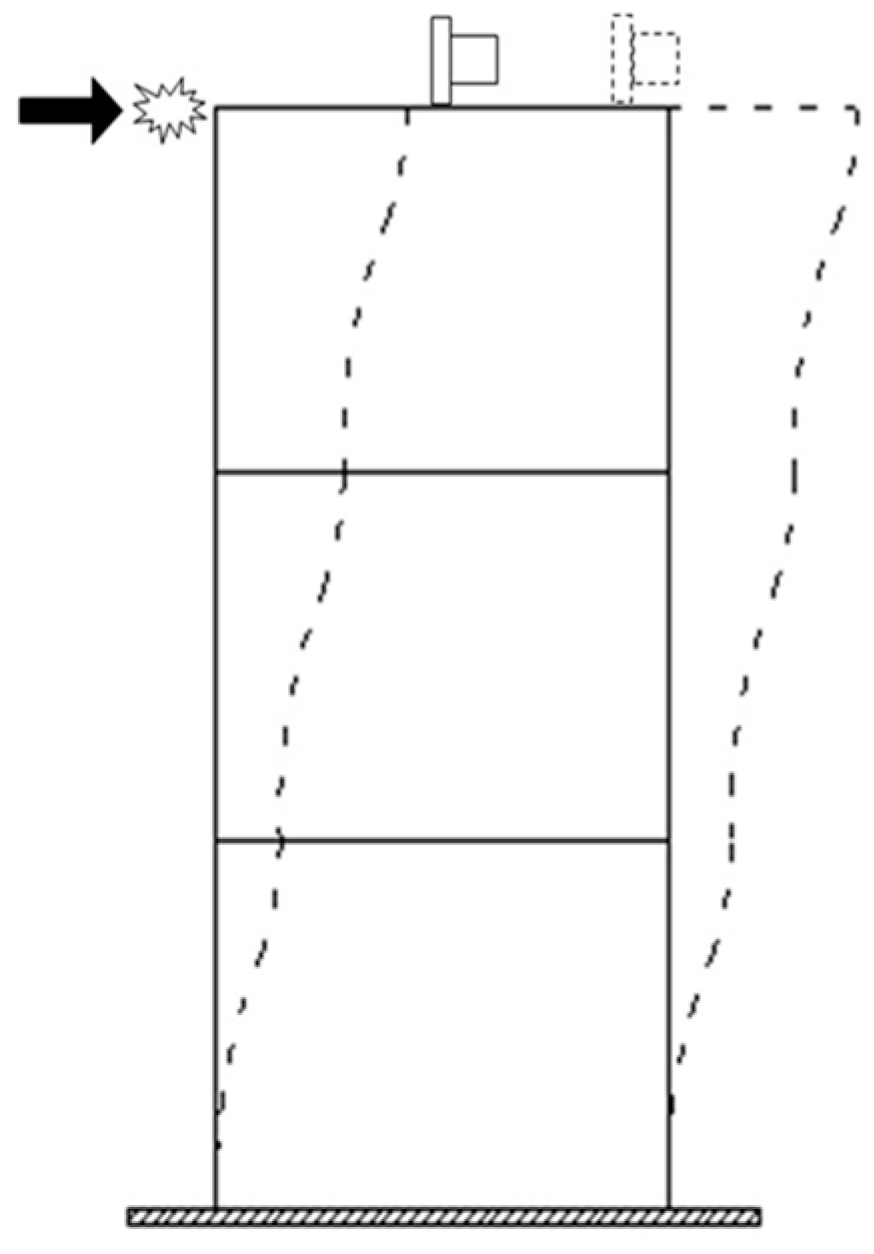
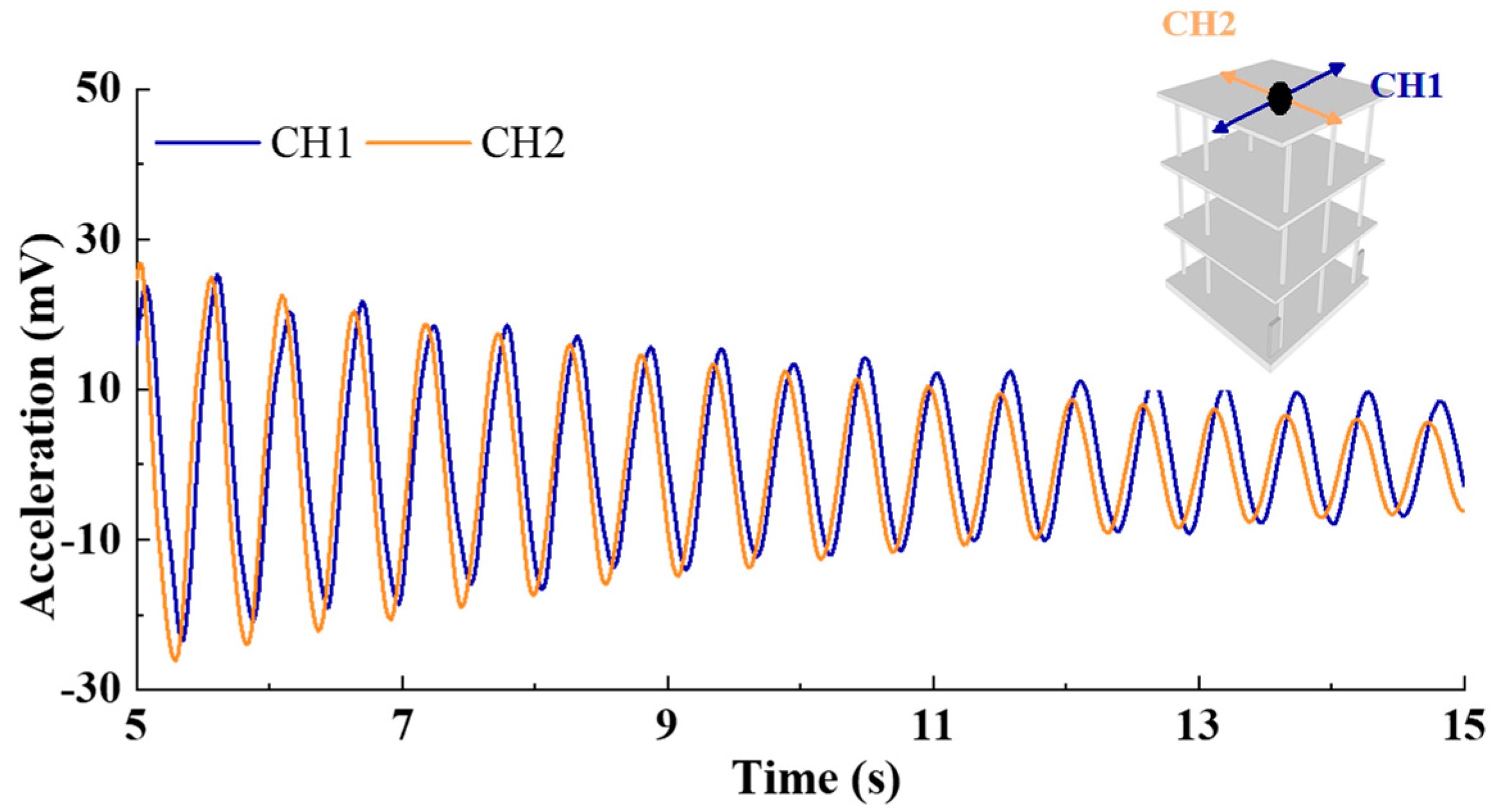

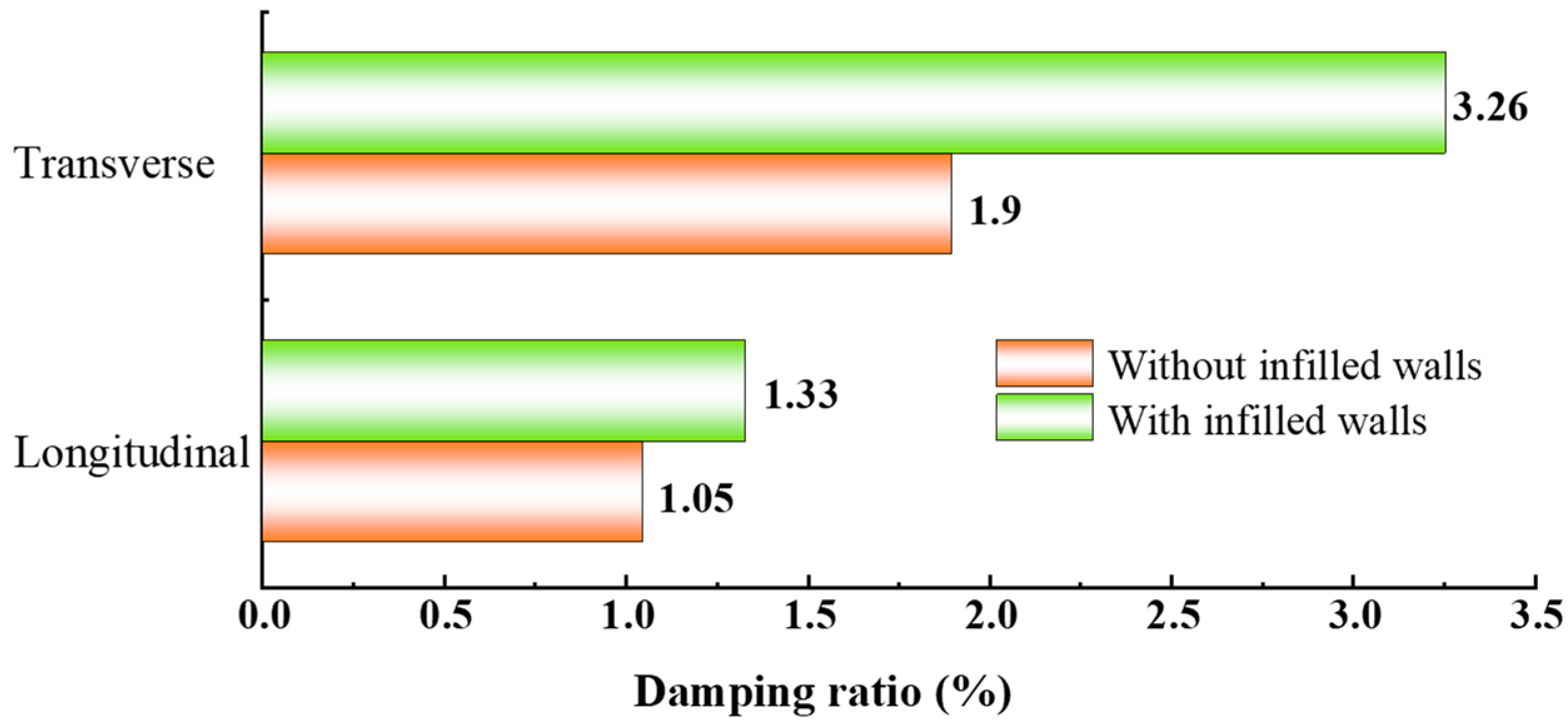
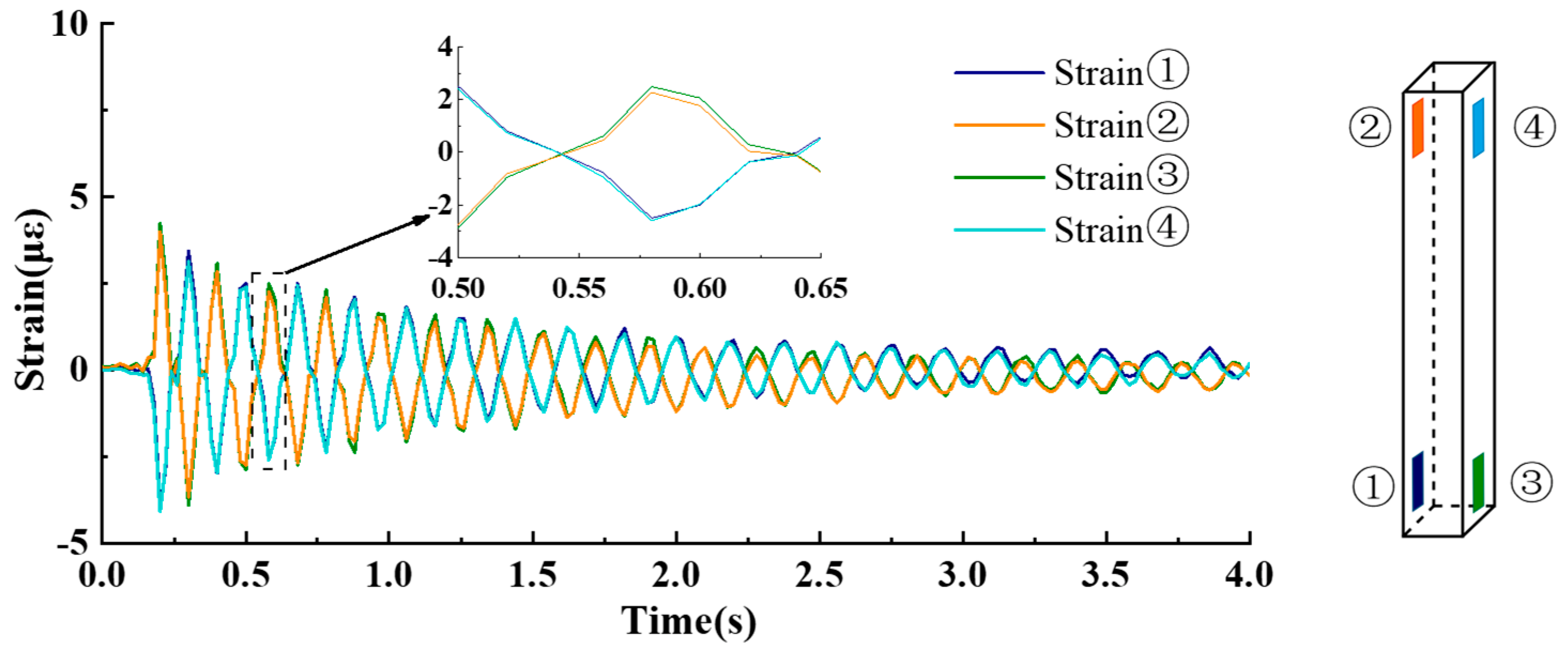
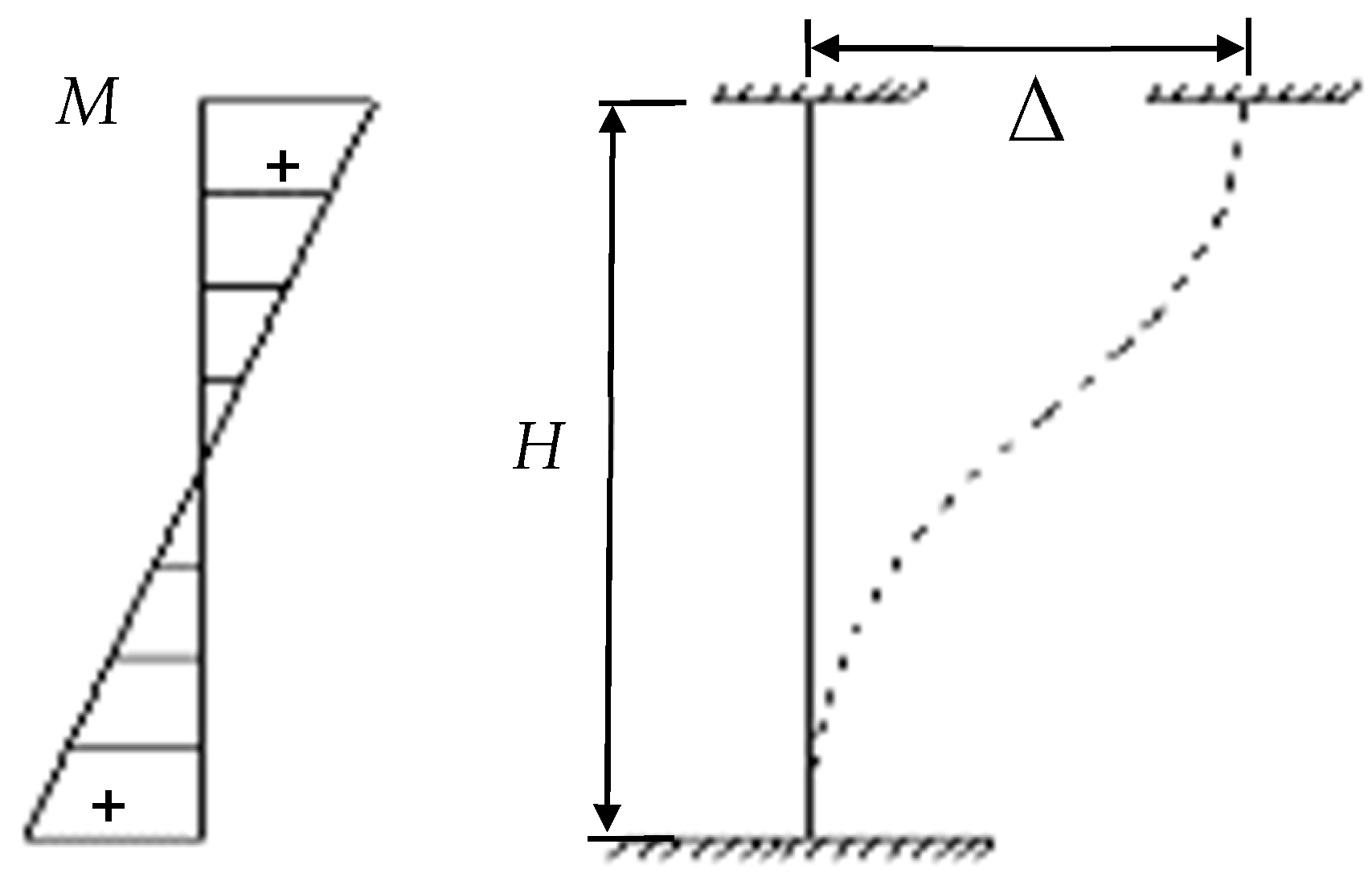
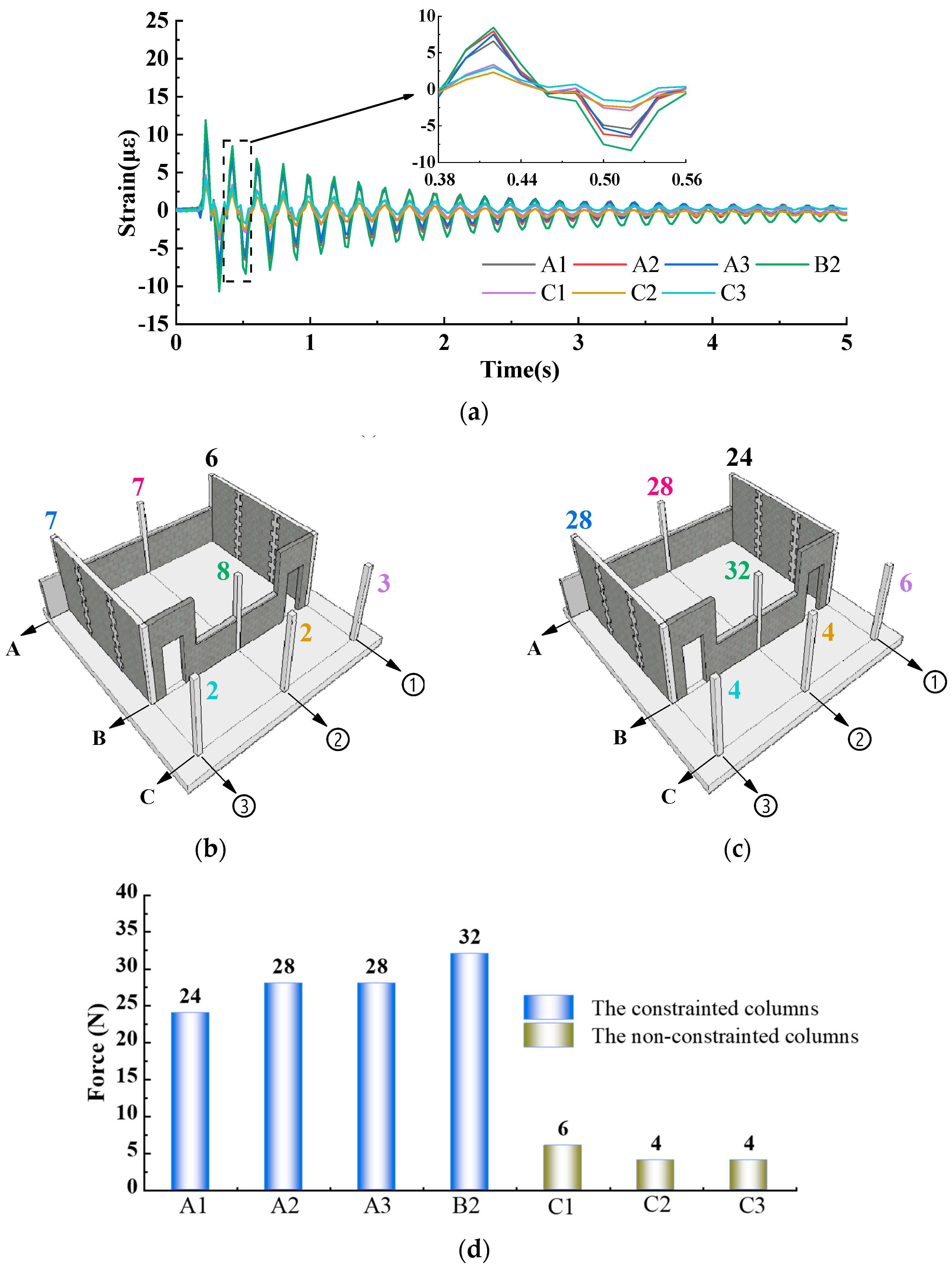
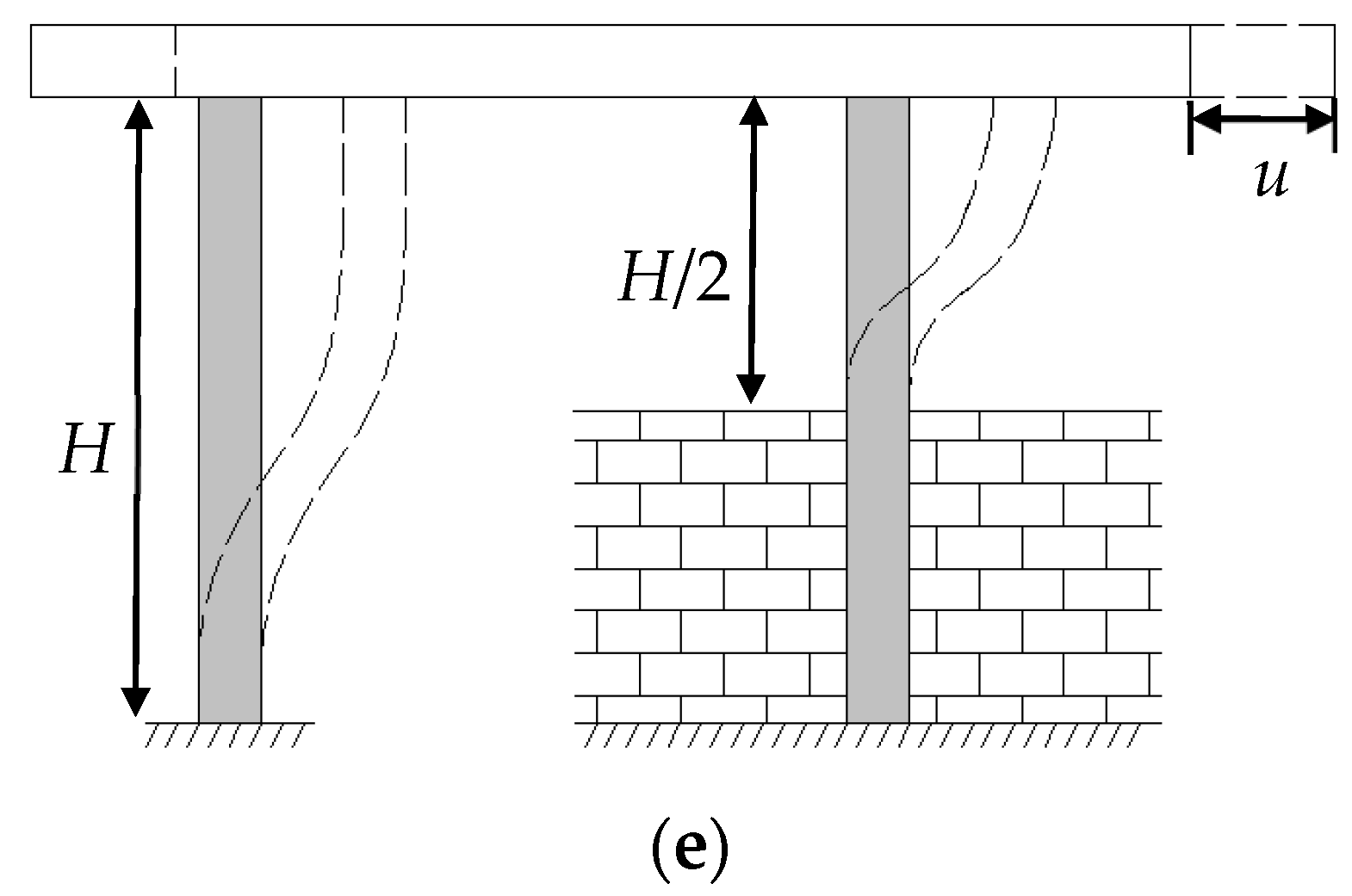

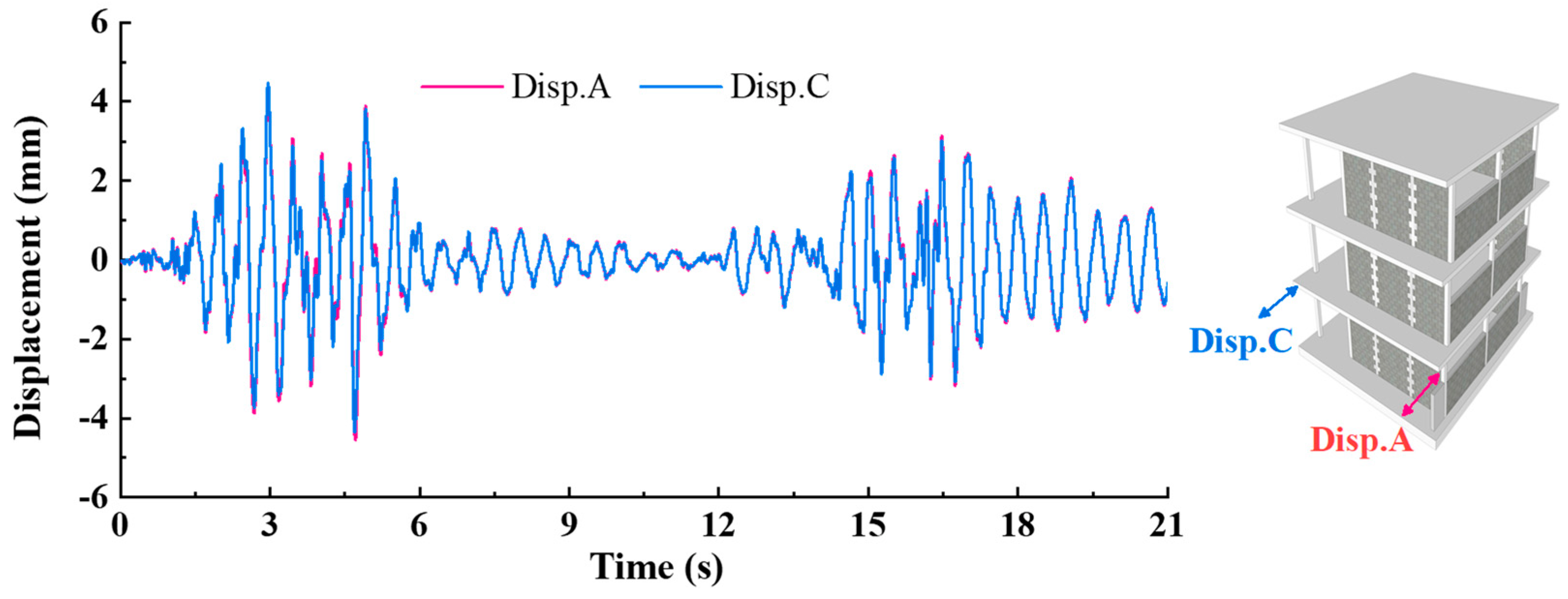
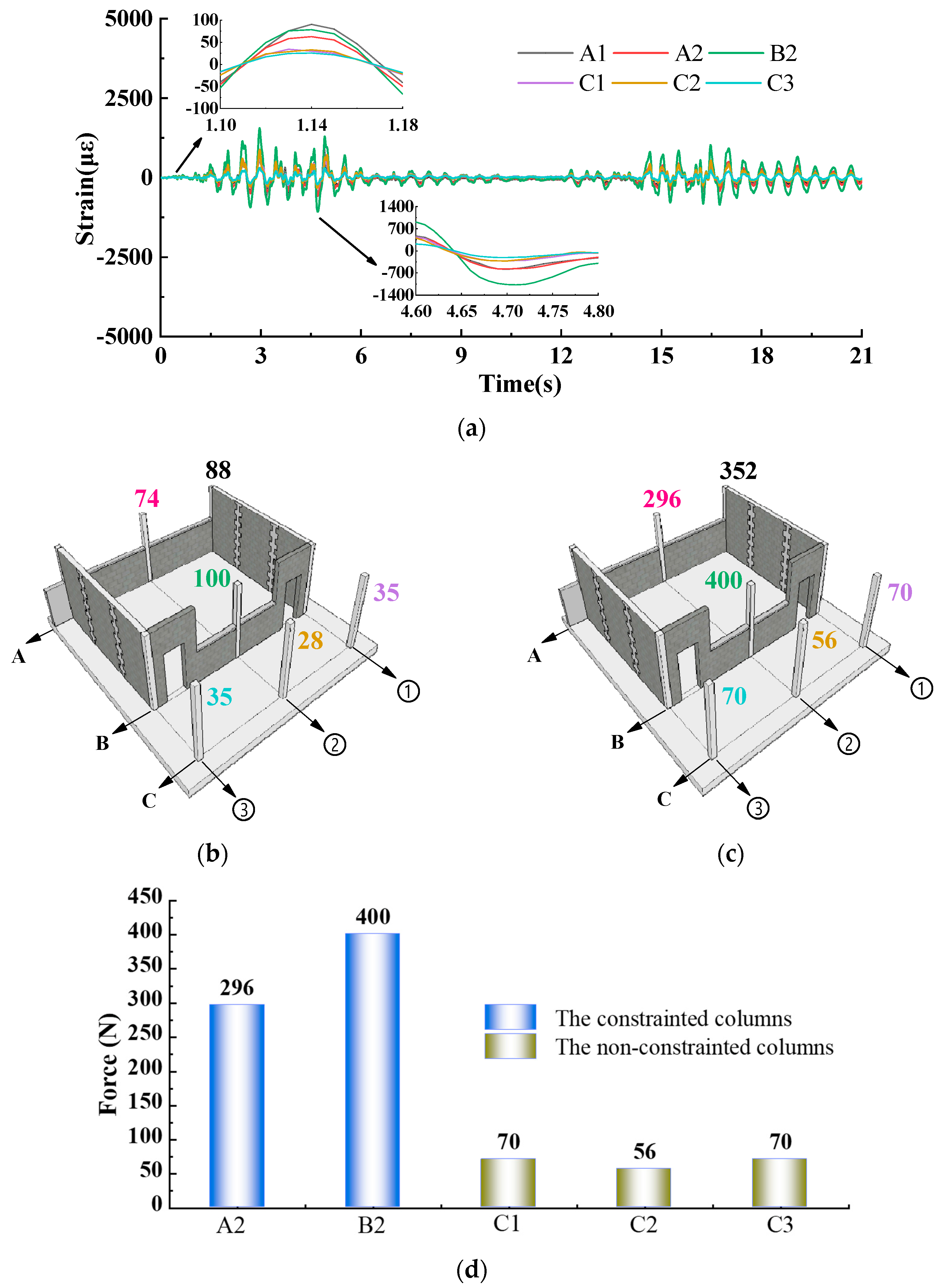

| Variable | Similarity Relation | Similarity Ratio |
|---|---|---|
| Length | lr | 0.25 |
| Elastic modulus | Er | 0.55 |
| Equivalent density | ρr = Er/lr | 2.20 |
| Stress | δr = Er | 0.55 |
| Time | 0.50 | |
| Velocity | 0.50 | |
| Acceleration | ar = 1 | 1.00 |
| Acceleration of gravity | gr = 1 | 1.00 |
| Frequency | 2.00 | |
| Artificial mass | 12.00 t |
Publisher’s Note: MDPI stays neutral with regard to jurisdictional claims in published maps and institutional affiliations. |
© 2022 by the authors. Licensee MDPI, Basel, Switzerland. This article is an open access article distributed under the terms and conditions of the Creative Commons Attribution (CC BY) license (https://creativecommons.org/licenses/by/4.0/).
Share and Cite
Wang, B.; Guo, X.; Xuan, Y.; Fan, X.-Q.; Chen, B. The Effects of Infilled Walls on Seismic Performance of RC Frame Structures with Eccentrically Placed Open Corridor. Sustainability 2022, 14, 5299. https://doi.org/10.3390/su14095299
Wang B, Guo X, Xuan Y, Fan X-Q, Chen B. The Effects of Infilled Walls on Seismic Performance of RC Frame Structures with Eccentrically Placed Open Corridor. Sustainability. 2022; 14(9):5299. https://doi.org/10.3390/su14095299
Chicago/Turabian StyleWang, Bo, Xun Guo, Yue Xuan, Xiao-Qing Fan, and Bo Chen. 2022. "The Effects of Infilled Walls on Seismic Performance of RC Frame Structures with Eccentrically Placed Open Corridor" Sustainability 14, no. 9: 5299. https://doi.org/10.3390/su14095299
APA StyleWang, B., Guo, X., Xuan, Y., Fan, X.-Q., & Chen, B. (2022). The Effects of Infilled Walls on Seismic Performance of RC Frame Structures with Eccentrically Placed Open Corridor. Sustainability, 14(9), 5299. https://doi.org/10.3390/su14095299





